Author Archive
What You Don't Know About Vermont's Dams
April 20th, 2015 | By: Infrastructure Report Card
What you probably don’t know about Vermont’s dams is that no one knows exactly what the condition of these structures is. Just as much as poor condition, it’s the lack of information that poses a risk to Vermont. This is the lesson Jessica Louisos, a civil engineer with the Waterbury firm Milone & MacBroom and a co-author of the Report Card for Vermont’s Infrastructure by the American Society of Civil Engineers, shares in a new PBS interview.Tags: dams, legislation, report card, Vermont
No Comments »
8 Amazing 1940s American Infrastructure Images
April 6th, 2015 | By: Infrastructure Report Card
As part of the Library of Congress’ Bound for Glory: America in Color exhibition of newly digitized color images taken of 1940s America, several show the infrastructure that people made their livings working on and that helped grow the country. The photographs are by famed photographers such as John Vachon, Jack Delano, Russell Lee, and Marion Post Wolcott and “mark a historic divide in visual presentation between the monochrome world of the pre-modern age and the brilliant hues of the present. They change the way we look—and think about—our past.”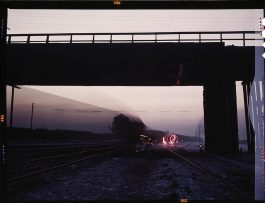
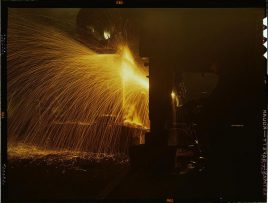





 Photos courtesy of the Library of Congress Bound for Glory Exhibition
Photos courtesy of the Library of Congress Bound for Glory Exhibition
Tags: dam, history, images, infrastructure, rail, road, train, transportation
No Comments »
Utah and Iowa Poised to Tackle Transportation
February 25th, 2015 | By: Infrastructure Report Card
On Tuesday, two ASCE Infrastructure Report Cards were released in two very different states – Iowa and Utah. Iowa’s Report Card showed one good B grade, seven mediocre Cs, and three poor Ds for the state’s infrastructure. Iowa’s roads earned a C- while bridges earned one of the lowest grades of D+. Utah’s Report Card earned good B+ grades for transportation categories but lower C and D grades for water and water resource infrastructure like drinking water, dams, and canals. Both Report Cards recommended leaders take action to supplement their current funding sources to meet both today’s issues and tomorrow’s needs.
Both state legislatures have been actively discussing their state’s transportation challenges with bills in both states being debated. Yesterday, Iowa legislators took rapid action passing bipartisan legislation through both the Senate and the House and sent the bill to the Governor’s desk. Today, Iowa’s Governor signed the bill marking a significant victory for improving transportation in the state. In Utah, a bill has been introduced that would raise 10 cents for every gallon of gas sold in Utah and provide an additional $237 million for transportation over the next two fiscal years. Many of Utah’s bridges will soon come to the end of their lifespan. The same goes for roads, many of which cannot keep pace with the increase in the number of motorist. Will Utah’s legislators take action before their session ends to ensure a good transportation system for the state’s future?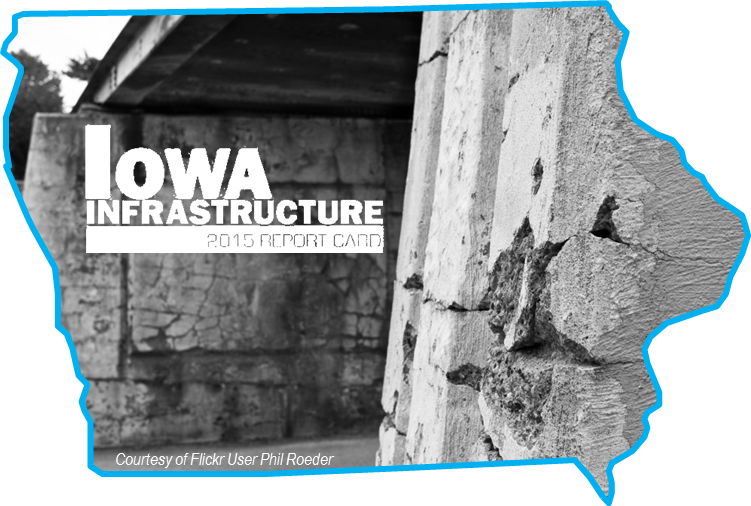
Utah's Infrastructure Receives First Report Card
February 23rd, 2015 | By: Infrastructure Report Card
Join the Utah Section of the American Society of Civil Engineers (ASCE) for the release of the 2015 Report Card for Utah’s Infrastructure on Tuesday, Feb. 24. The report includes evaluation of Utah’s bridges, canals, dams, drinking water & supply, hazardous waste, levees, roads, solid waste, transit, and wastewater & stormwater. WHAT: Press Release of the 2015 Report Card for Utah’s Infrastructure WHO: Utah Section of the American Society of Civil Engineers David Eckhoff, P.E., PhD, American Society of Civil Engineers Andrew Gruber, Executive Director, Wasatch Front Regional Council Ari Buening, COO, Envision Utah WHEN: Tuesday, Feb. 24, 2015, 10 a.m. WHERE: Utah State Capitol Presentation Room, First Floor, Salt Lake, UT WHY: Infrastructure has a direct impact on our lives every day—from the water we drink, to the roads and rails we travel. Infrastructure is vital to our economy, security, recreation and safety. Will Utah’s infrastructure systems make the grade? Can’t attend but want to see the Report Card tomorrow? Find it here.Tags: infrastructure, report card, Utah
No Comments »
2015 Report Card for Iowa’s Infrastructure Arrives Next Tuesday
February 19th, 2015 | By: Infrastructure Report Card
The Iowa Section of the American Society of Civil Engineers (ASCE) will release the inaugural 2015 Report Card for Iowa’s Infrastructure on Tuesday, February 24. The report includes evaluations of Iowa aviation, rail, inland waterways, roads, bridges, dams, levees, drinking water, wastewater, electrical energy, and solid waste.News conference on release of the 2015 Report Card for Iowa’s Infrastructure
WHO: American Society of Civil Engineers – Iowa Section
Speakers:
- Joe Spradling, P.E., president, Iowa Section ASCE
- Aaron Granquist, P.E., author and member, Report Card Committee
- Director Debi Durham, Iowa Economic Development Authority
WHEN: Tuesday, February 24, 2015 at 10:30 am
WHERE: Wallace Building Auditorium, 502 E 9th Street, Des Moines, Iowa
Tags: bridges, economy, infrastructure, Iowa, report card, roads, transportation, water
No Comments »
Show Your Love for Infrastructure
February 13th, 2015 | By: Infrastructure Report Card
Since we launched our Infrastructure Friends network with the release of ASCE’s 2013 Report Card for America’s Infrastructure we’ve seen a wave of new momentum on infrastructure issues in every state and in DC. We hope you’ll join our effort and be a friend to America’s infrastructure!
Tags: friend, infrastructure, report card
No Comments »
Virginia's Infrastructure Struggle for Status Quo
January 23rd, 2015 | By: Infrastructure Report Card
With a state that’s growing as fast as Virginia, you’re bound to have growing pains, but none are as striking or obvious as the traffic gridlock across the state. So, would you be surprised that the Virginia Section of the American Society of Civil Engineers gave roads a D grade in their new 2015 Report Card for Virginia’s Infrastructure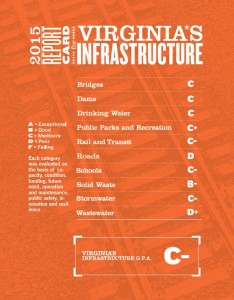 ? While some big steps were taken by the legislature in 2013 to bring renewed funding to transportation, may end up only keeping the status quo of transportation troubles across the state whether by car or transit. Another growing pain issue for Virginia is there are a lot of dams in the state (1,789 to be exact) and the number of people that now live behind old dams has increased with the growth of the state. The majority of dams were constructed between 1950 and 1975, making the average age more than 50 years old. With an increasing population, more houses and businesses are now below dams which means there’s more risk for damage and lives being lost if there was a failure. The good news is that Virginia has made a lot of progress in identifying and educating owners on how to fix dams that are considered high-hazard, but the bad news is that 141 of these high-hazard dams do not meet current dam safety standards, resulting in a grade of C for Virginia’s dams. Growth is also affecting schools as localities try to keep up with growing schools in some areas and older school maintenance in localities that seem to be losing students and residents.
Not only is Virginia growing, but its infrastructure is also starting to show its age with basic services like water, wastewater, and stormwater representing the old infrastructure bones of the cities. Virginia’s 2,830 public water systems providing drinking water to more than 7 million Virginians, and the Report Card found that many of these systems are 70 years or older and require significant asset renewal in the immediate future. The bad news is that funding is slim – from 2000 to 2012, the state only saw $200 million in Drinking Water State Revolving Funds, which is less than 10% of the commonwealth’s total investment needs. Wastewater needs have jumped 45%, and best estimates show $1 billion is needed to control overflows that pollute local waters. Also, stormwater systems are equally old, and surveys show about one-third of the infrastructure is older than 50 years and much of the remainder was built 25 to 50 years ago. While every bit of funding helps, the reality is Virginia’s water systems are only getting older each day and each dollar available is being split between trying to fix yesterday’s problems and today’s.
Growth and age are like a one-two punch to Virginia’s infrastructure causing a real struggle to maintain an acceptable level of infrastructure service for the state. Virginia’s C- infrastructure shows the Commonwealth is barely maintaining the status quo, and without significant change, it will be a struggle to maintain even the current gridlock of roads and frequent water pipe breaks without new solutions. In the Report Card, they give 3 solutions to raise Virginia’s grades:
1. Increase Leadership in Infrastructure Renewal: Virginia’s infrastructure is the responsibility of all our leaders. We need bold leadership and a vision for how strategic infrastructure investment can improve the current status quo.
2. Promote Sustainability and Resilience: Today’s infrastructure must meet the state’s needs in the best and worst of times, and also protect and improve the environment and our quality of life.
3. Develop Comprehensive Strategies: Virginia should prioritize and execute infrastructure strategies that put our investments where they are needed most, according to well-conceived plans that focus on comprehensive solutions that provide a good return on investment.
The Virginia legislature is just getting started, and there is no better time for them to take a second look at the infrastructure they are responsible for than now with a fresh update from the civil engineers who work on the state’s infrastructure every day.
? While some big steps were taken by the legislature in 2013 to bring renewed funding to transportation, may end up only keeping the status quo of transportation troubles across the state whether by car or transit. Another growing pain issue for Virginia is there are a lot of dams in the state (1,789 to be exact) and the number of people that now live behind old dams has increased with the growth of the state. The majority of dams were constructed between 1950 and 1975, making the average age more than 50 years old. With an increasing population, more houses and businesses are now below dams which means there’s more risk for damage and lives being lost if there was a failure. The good news is that Virginia has made a lot of progress in identifying and educating owners on how to fix dams that are considered high-hazard, but the bad news is that 141 of these high-hazard dams do not meet current dam safety standards, resulting in a grade of C for Virginia’s dams. Growth is also affecting schools as localities try to keep up with growing schools in some areas and older school maintenance in localities that seem to be losing students and residents.
Not only is Virginia growing, but its infrastructure is also starting to show its age with basic services like water, wastewater, and stormwater representing the old infrastructure bones of the cities. Virginia’s 2,830 public water systems providing drinking water to more than 7 million Virginians, and the Report Card found that many of these systems are 70 years or older and require significant asset renewal in the immediate future. The bad news is that funding is slim – from 2000 to 2012, the state only saw $200 million in Drinking Water State Revolving Funds, which is less than 10% of the commonwealth’s total investment needs. Wastewater needs have jumped 45%, and best estimates show $1 billion is needed to control overflows that pollute local waters. Also, stormwater systems are equally old, and surveys show about one-third of the infrastructure is older than 50 years and much of the remainder was built 25 to 50 years ago. While every bit of funding helps, the reality is Virginia’s water systems are only getting older each day and each dollar available is being split between trying to fix yesterday’s problems and today’s.
Growth and age are like a one-two punch to Virginia’s infrastructure causing a real struggle to maintain an acceptable level of infrastructure service for the state. Virginia’s C- infrastructure shows the Commonwealth is barely maintaining the status quo, and without significant change, it will be a struggle to maintain even the current gridlock of roads and frequent water pipe breaks without new solutions. In the Report Card, they give 3 solutions to raise Virginia’s grades:
1. Increase Leadership in Infrastructure Renewal: Virginia’s infrastructure is the responsibility of all our leaders. We need bold leadership and a vision for how strategic infrastructure investment can improve the current status quo.
2. Promote Sustainability and Resilience: Today’s infrastructure must meet the state’s needs in the best and worst of times, and also protect and improve the environment and our quality of life.
3. Develop Comprehensive Strategies: Virginia should prioritize and execute infrastructure strategies that put our investments where they are needed most, according to well-conceived plans that focus on comprehensive solutions that provide a good return on investment.
The Virginia legislature is just getting started, and there is no better time for them to take a second look at the infrastructure they are responsible for than now with a fresh update from the civil engineers who work on the state’s infrastructure every day.
Tags: dams, infrastructure, resilience, schools, stormwater, sustainability, Virginia, wastewater, water
No Comments »
Infrastructure Quotes from the State of the Union
January 22nd, 2015 | By: Infrastructure Report Card
 The State of the Union is the time for some of the most pressing issues of the day to be highlighted, and infrastructure certainly made the list in the 2015 State of the Union. Here is what the President had to say about America’s infrastructure:
We gave our citizens schools and colleges, infrastructure and the Internet, tools they needed to go as far as their efforts and their dreams will take them. That’s what middle-class economics is: the idea that this country does best when everyone gets their fair shot, everyone does their fair share, everyone plays by the same set of rules.
____
That’s why the third part of middle-class economics is all about building the most competitive economy anywhere, the place where businesses want to locate and hire.
21st century businesses need 21st century infrastructure: modern ports, and stronger bridges, faster trains and the fastest Internet.
____
Democrats and Republicans used to agree on this. So let’s set our sights higher than a single oil pipeline; let’s pass a bipartisan …
… infrastructure plan that could create more than 30 times as many jobs per year and make this country stronger for decades to come.
Let’s do it. Let’s get it done.
____
Now, the truth is when it comes to issues like infrastructure and basic research, I know there’s bipartisan support in this chamber. Members of both parties have told me so.
Where we too often run onto the rocks is how to pay for these investments. As Americans, we don’t mind paying our fair share of taxes, as long as everybody else does too.
____
That’s why the third part of middle-class economics is all about building the most competitive economy anywhere, the place where businesses want to locate and hire.
21st century businesses need 21st century infrastructure: modern ports, and stronger bridges, faster trains and the fastest Internet.
Listen to the full 2015 State of the Union address here.
The State of the Union is the time for some of the most pressing issues of the day to be highlighted, and infrastructure certainly made the list in the 2015 State of the Union. Here is what the President had to say about America’s infrastructure:
We gave our citizens schools and colleges, infrastructure and the Internet, tools they needed to go as far as their efforts and their dreams will take them. That’s what middle-class economics is: the idea that this country does best when everyone gets their fair shot, everyone does their fair share, everyone plays by the same set of rules.
____
That’s why the third part of middle-class economics is all about building the most competitive economy anywhere, the place where businesses want to locate and hire.
21st century businesses need 21st century infrastructure: modern ports, and stronger bridges, faster trains and the fastest Internet.
____
Democrats and Republicans used to agree on this. So let’s set our sights higher than a single oil pipeline; let’s pass a bipartisan …
… infrastructure plan that could create more than 30 times as many jobs per year and make this country stronger for decades to come.
Let’s do it. Let’s get it done.
____
Now, the truth is when it comes to issues like infrastructure and basic research, I know there’s bipartisan support in this chamber. Members of both parties have told me so.
Where we too often run onto the rocks is how to pay for these investments. As Americans, we don’t mind paying our fair share of taxes, as long as everybody else does too.
____
That’s why the third part of middle-class economics is all about building the most competitive economy anywhere, the place where businesses want to locate and hire.
21st century businesses need 21st century infrastructure: modern ports, and stronger bridges, faster trains and the fastest Internet.
Listen to the full 2015 State of the Union address here.
Tags: congress, infrastructure, President, SOTU
No Comments »
Dams in 26 States Are Getting Some TLC
December 30th, 2014 | By: Infrastructure Report Card
While the average person might think it’s just about farms, the Farm Bill funding for dams was perhaps one of the most unsung wins for infrastructure in 2014. The 2014 Farm Bill that Congress passed in the summer provided USDA with $262 million to distribute to states for rehabilitating dams. The funding provided rehabilitation assistance for 150 dams in 26 states. This increased the typical annual investment in rehabilitation 20 times over! Dam infrastructure’s role in flood management, water supply, and agricultural productivity is critical to the economy. Here’s a quick breakdown of the Watershed Rehabilitation assistance by state:| Project Name | Assistance Provided |
| Arizona | $98,137,300 |
| Texas | $33,842,975 |
| Oklahoma | $26,420,000 |
| West Virginia | $14,200,099 |
| Utah | $12,655,000 |
| Pennsylvania | $11,380,500 |
| Massachusetts | $8,976,000 |
| Nebraska | $7,515,236 |
| Virginia | $7,285,000 |
| Mississippi | $5,675,000 |
| Colorado | $2,940,000 |
| New York | $2,900,000 |
| Tennessee | $2,300,000 |
| Kansas | $1,751,000 |
| Oregon | $1,374,000 |
| Kentucky | $1,163,000 |
| Ohio | $708,000 |
| New Mexico | $600,000 |
| Wyoming | $543,103 |
| Connecticut | $450,000 |
| Arkansas | $445,500 |
| North Dakota | $294,000 |
| Nevada | $280,000 |
| Idaho | $249,000 |
| Georgia | $225,000 |
| New Hampshire | $50,000 |
Tags: congress, dams, Farm Bill, safety, states
No Comments »
Nevada Report Card Reveals a $15B Infrastructure Problem
December 16th, 2014 | By: Infrastructure Report Card
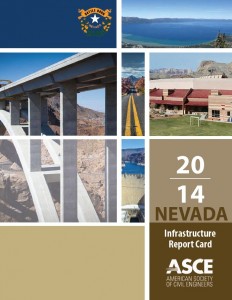 During the past twenty years Nevada experienced one of the largest growth surges in the country and then one of the worst downturns from late 2008 through 2013. This roller coaster economy decreased funding levels and preventive maintenance suffered leaving many infrastructure systems underfunded. Hardest hit may be school facilities in both rural communities and cities. Nevada’s funding for maintaining schools stagnated and left a funding shortfall of over $5 billion during the next 5 to 10 years.
The 2014 Report Card for Nevada’s Infrastructure, released today by the Nevada Section of the American Society of Civil Engineers (ASCE), gave the state’s infrastructure a grade of “C-.” The Report Card identifies more than 15 billion in needs across Nevada’s critical infrastructure sectors over 20 years, including:
Dams and Flood Control:
During the past twenty years Nevada experienced one of the largest growth surges in the country and then one of the worst downturns from late 2008 through 2013. This roller coaster economy decreased funding levels and preventive maintenance suffered leaving many infrastructure systems underfunded. Hardest hit may be school facilities in both rural communities and cities. Nevada’s funding for maintaining schools stagnated and left a funding shortfall of over $5 billion during the next 5 to 10 years.
The 2014 Report Card for Nevada’s Infrastructure, released today by the Nevada Section of the American Society of Civil Engineers (ASCE), gave the state’s infrastructure a grade of “C-.” The Report Card identifies more than 15 billion in needs across Nevada’s critical infrastructure sectors over 20 years, including:
Dams and Flood Control:
- With the majority of funding for flood management coming from local gas and sales tax initiatives, there continues to be projected funding shortfalls upwards of $400 million.
- The state has 158 high hazard dams, which could lead to loss-of-life or significant property damage if dam failure occurs.
- The state budget for high hazard dams is nearly half the national average.
- In 2005, $500,000 of investments were made in aviation through the Nevada Aviation Trust Fund, resulting in an economic impact of over $20 million. However, since that time no state funding has been allocated into the Trust Fund to leverage federal funding.
- The Nevada Department of Transportation maintains 5,300 miles of state highways, which include many rural roadways within Nevada.
- Current funding levels provide only 60 to 70 percent of the required funding to maintain state highways.
- In Clark and Washoe Counties, 45 percent of schools are more than 30 years old.
- In other counties throughout the state, there are schools with campuses over 100 years old.
- Every dollar held back from school operation and maintenance budgets escalates emergency repair budgets 400 percent.
Tags: #HighwayTrustFund, dams, flood control, Nevada, report card, roads, schools
No Comments »



 */ ?>
*/ ?>














